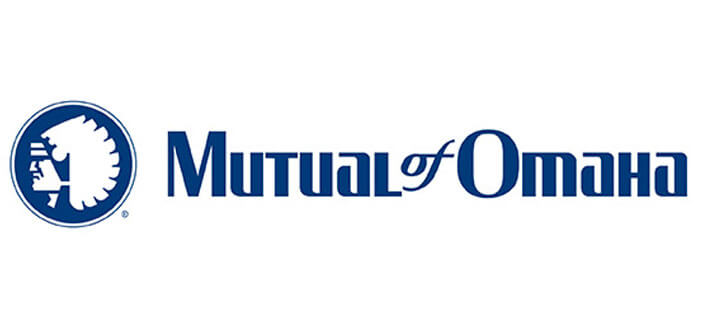We do not offer every plan available in your area. Any information we provide is limited to those plans we do offer in your area. Please contact Medicare.gov or 1-800-MEDICARE (TTY users should call 1 (877) 486-2048) 24 hours a day/7 days a week to get information on all of your options.
Mutual of Omaha Medicare Supplement Review
Mutual of Omaha, which underwrites the Mutual of Omaha Medicare Supplement, began in Nebraska in 1909 under the name Mutual Benefit Health & Accident Association. Since 1966, Mutual of Omaha has been dealing with Medicare since the company was selected to administer Parts A and B. Mutual of Omaha Medicare Supplement coverage is available to those age 65 and older or those under 65 with qualifying disabilities such as end-stage renal disease. As with all Medicare supplement plans, the Federal government regulates the policy coverage.
Pros
- Works with any Medicare provider
- International coverage is an option
Cons
- Does not work with all parts of Medicare
Medicare Part A, B, C, and D Basics
Before we discuss Mutual of Omaha Medicare Supplement insurance, let’s take a look at Medicare’s various coverage types, designated by letters for each plan.
Part A is hospital insurance. It covers inpatient care, inpatient nursing, and inpatient services and supplies. It is the part of Medicare that is also responsible for hospice service and home health service coverage. Most people would not pay a premium for Part A if they paid Medicare taxes through employment over the years.
Part A currently does not have a premium cost if the beneficiary paid Medicare taxes for 10 years or 40 quarters. For those who paid between 30 and 39 quarters, the monthly premium is $232. Those who worked less than 30 quarters pay $422. There is also a $1,340 deductible each year. After the deductible, there are coinsurance costs, which is a percentage of the bill you are responsible for paying. For inpatient hospital stays over 60 days, you will have a coinsurance cost for each day you use the benefits.
Part B is the part of Medicare that deals with your general medical care. It covers doctors visits, outpatient care, home health in some cases, and other medical services. Part B includes medically necessary care and preventative care services in many cases. Medicare Part B usually has a monthly or annual premium paid for coverage to be in effect. Plan B premiums start at $134 a month. However, those receiving Social Security benefits may pay less, and those with higher incomes will pay more. Part B deductibles are lower than Part A, at $138 per year. After that, coinsurance of 20 percent is the responsibility of the beneficiary for most doctor services.
| Part A | Part B | Part C | Part D | |
|---|---|---|---|---|
| Supplemental Insurance Works With: |
Yes | Yes | No | No |
Commonly called a Medicare Advantage Plan, Part C replaces traditional Parts A and B. For the cost of the premium, government-authorized private health insurance companies provide these plans. While there are guidelines as to what Part C can and cannot offer, Part C plans vary quite a bit in design and how they operate. Some may rely on insurance provider medical networks or require referrals. Health maintenance organization (HMO), preferred provider organization (PPO), private fee for service, medical savings account, and special needs plans are all types of insurance offered under Plan C.
Part D is a drug insurance plan. Again, like Part C, this is offered by private insurance companies for a premium, with the approval of the federal government. Part D may involve copays, coinsurance, and deductible fees but can still lower your overall drug costs due to pharmacy discounts given to the insurer.
Mutual of Omaha Prices
Monthly cost depends on multiple factors like your age, sex, location and whether or not you use tobacco products. We got a quote for a non-tobacco using male born in 1950 in Oklahoma. Mutual of Omaha offers five plans in Oklahoma.
-
High-Deductible Plan F: $41.58 per month
-
Plan N: $87.33 per month
-
Plan G: $113.03 per month
-
Plan A: $135.09 per month
-
Plan F: $163.00 per month
All of these plans covered some or all of: Basic benefits, skilled nursing facility coinsurance, Medicare Part A deductible (hospital insurance), Medicare Part B deductible (medical insurance), Medicare Part B, Excess Charges and Foreign Travel Emergency.
Mutual of Omaha Medicare Supplement Insurance Coverage
To use Mutual of Omaha Medicare Supplement Insurance, provide the insurance information along with your Medicare information to your doctor, hospital, or other medical services provider. Your claims are then submitted to both insurance programs.
Medicare pays first, then Mutual of Omaha Medicare Supplement Insurance picks up all or part of the remaining amount, depending on the plan selected. You only pay the remaining amount after both insurances payout. Mutual of Omaha Medicare Supplement Insurance offers 10 plans overall, although all are not available in every state. Premiums vary by plan, beneficiary age and sex and whether or not the beneficiary is a smoker. For example, in one region, premiums ranged from just over $87 a month to over $300 a month.
While there are far too many variables in Mutual of Omaha’s plans to outline each one here, we covered the high points of the most popular supplemental insurances, Plans A, F, G, and N. Medicare offers a chart of the regulated parts of these plan offerings.

Mutual of Omaha Medicare Supplement Basic Benefits
Every plan offered by Mutual of Omaha Medicare Supplement includes basic benefits. For hospitalization, these are coinsurance coverage plus 365 days additional coverage beyond Medicare Part A limits, plus hospice coinsurance coverage. For Medicare Part B medical coverage, the basic benefits are coinsurance coverage and copay coverage for hospital outpatient events. However, the amount of Part B coinsurance covered varies by plan. The basic benefits also include the first three pints of blood that Medicare does not cover.
Mutual of Omaha Medicare Supplement Plan A
Not to be confused with Medicare Part A, the Plan A supplement is the basic Medicare supplement plan that all supplemental insurance companies must offer before selling other options. Plan A is meant to cover coinsurance for Part A and Part B with additional coverage for 365 days beyond the Medicare Part A limit. This plan includes 100 percent of Part B coinsurance. Plan A is the lowest cost supplement plan offered.
Mutual of Omaha Medicare Supplement Plan F
Plan F supplement is a complete plan compared to others, although it has considerably higher premiums than Plan A. It includes everything under the basic and Plan A coverage. Benefits include skilled nursing facility coinsurance charges, Part A and Part B deductibles, a medical emergency during foreign travel coverage rider, and covers Part B excess charges (the up to 15 percent over Medicare reimbursement physicians are allowed to charge patients in some cases).
Mutual of Omaha Medicare Supplement Plan G
Plan G is almost identical to Plan F except that it does not cover Part B deductibles.
Mutual of Omaha Medicare Supplement Plan N
Plan N includes the basic coverage but focuses more on hospital coverage than outpatient care. It includes skilled nursing facility coinsurance, the medical emergency during foreign travel coverage rider, and covers the Part A deductible. While this plan includes 100 percent Part B coinsurance, it requires patients to pay a $20 copay for each doctor visit and a $50 copay for each emergency room visit. While your monthly premiums are lower for Plan N, you have to pay the Medicare Plan B deductible of $183.
Mutual of Omaha Medicare Supplement Complaints
The Better Business Bureau gives the Mutual of Omaha family of companies an A+ rating with only 111 complaints in the last three years. The majority of these complaints dealt with billing and advertising and did not all pertain to the Medicare Supplement business.

Prescriptions. Source: Getty
Mutual of Omaha Medicare Supplement Q&A
-
Does Mutual of Omaha offer a Medigap policy?
Yes. A Medigap policy is the same insurance as a Medicare supplement plan; it is just another name for it. -
Where do I go to get more information about Medicare supplement insurance?
Start by reading the tips for a wise buyer in our Medicare supplement insurance buyer’s guide, paying special attention to the frequently asked questions. You can get free assistance with all Medicare-related questions from your State Health Insurance Assistance Program (SHIP). Administration for Community Living (ACL), U.S. Department of Health and Human Services (DHHS) funds this program. Select your state on their website to get the phone and other contact information. -
What is a copay?
A copay is a fee, often a small amount such as $20, that a patient must pay to a provider regardless of any insurance coverage. This amount is not usually included in the deductible calculation and may not always be included in the maximum out of pocket cost calculations. Copays are intended to remind beneficiaries that medical care is not free, to reduce overuse of the insurance. -
What is coinsurance?
Coinsurance is a percentage of costs that the beneficiary is responsible for paying, commonly 20 percent. Coinsurance is calculated off of the allowed amount, that is, the negotiated cost of service set between the insurance company and the provider, not the initial billed rate. -
What is a beneficiary?
A beneficiary is a person who receives benefits from an insurance policy. If you are paying premiums and using the insurance when you seek medical help, you are a beneficiary. If you have insurance that covers a spouse, or you have covered dependent children, each of these people is a beneficiary. -
What is a deductible?
A deductible is a set amount of money paid by the beneficiary before insurance pays for any services. For example, Medicare Part A has a $1,340 deductible that you must pay before Medicare pays for any services. You still need to file claims while you are paying the deductible because the deductible amount should be based off allowed amounts, not raw billed rates. -
When can I buy a Medicare supplement plan?
You can apply for Medicare supplement insurance under a variety of circumstances, which are relatively extensive and give you many options. As long as you are eligible for Medicare, you may be able to buy a supplement plan during the open enrollment period. This period is six months beginning the first day of the month in which you are 65 years old or older and enrolled in Medicare Part B. You can also buy a new supplement plan if you leave a Medicare Advantage plan or your employer discontinues coverage.
Conclusion
Mutual of Omaha Medicare Supplement offers the regulated plans allowed by Medicare rules with additional coverages where possible. As one of the original Medicare administration companies, Mutual of Omaha has the history and experience to understand how to work with Medicare effectively for its clients. You can discuss the plans available in your state with your insurance agent, or apply over the phone by calling between 8 a.m. and 8 p.m. central time, Monday through Friday.


